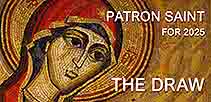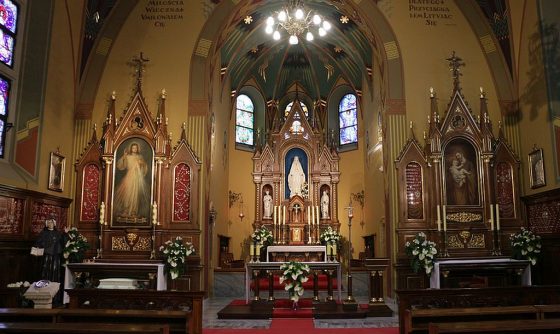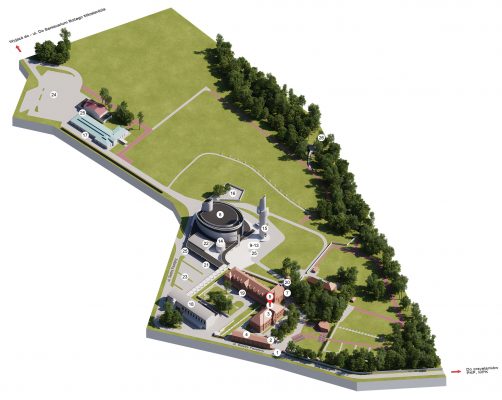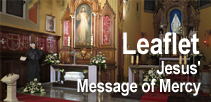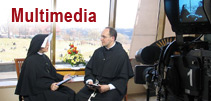We have put a map of the Shrine after the text.
We are now at the very heart of the Łagiewniki Shrine, the Chapel which contains the Holy Picture of the Merciful Jesus, renowned for the miracles it has wrought, and the Tomb of St. Faustina. The Chapel is located between the main building of the convent and the House of Mercy, the building in which the Sisters have always conducted, and continue to conduct their Congregation’s apostolic work. In 1891, Cardinal Albin Dunajewski consecrated this fairly small house of worship as St. Joseph’s Chapel. By 1968, so many pilgrims were coming here to pray before the Holy Picture of the Merciful Jesus and at Sister Faustina’s graveside that Cardinal Karol Wojtyła entered the Chapel on the list of sanctuaries in the Archdiocese of Kraków, and in 1992, “in consideration of the rapidly expanding devotion to the Divine Mercy,” Cardinal Franciszek Macharski issued a decree appointing the Chapel the official Sanctuary of the Divine Mercy.
The main altar was designed by Ferdynand Majerski, a sculptor and wood-carver from Przemyśl, and contains a statue of Our Lady of Mercy, Patroness of the Congregation, flanked on the left by a statue of St. Stanislaus Kostka, Patron Saint of young religious, and on the right by St. Mary Magdalene, Patron Saint of repentant women. The altar on the left-hand side of the chancel holds the Holy Picture of the Merciful Jesus (by Adolf Hyła, 1944). This painting, renowned for working miracles, was put up over a picture of the Sacred Heart (by Jan Bąkowski, 1896), the original altarpiece. The right-hand side altar has a picture of St. Joseph with the Infant Jesus (by Franciszek Krudowski, late 19th-c.) over it. The historic wall paintings were designed in 1934 by Zdzisław Gedliczka. During a general overhaul and conservation project carried out in 1981-1990, a set of stained-glass decorations designed by Wiktor Ostrzołek was mounted in the windows along the sides of the Chapel and in its entrance porch. The only stained-glass window predating those by Wiktor Ostrzołek is that of St. Cecilia in the ocular (round) window at the back of the musicians’ choir. The walls of the chapel are decorated with glass cabinets displaying votive offerings donated by pilgrims in thanksgiving for the graces they have received here.
This is the Chapel where Sister Faustina attended daily Mass, went to Confession every week, took part every night in the evening service and Benediction, every day conducted an hour of Meditation, examined her conscience, did her spiritual reading, made the Way of the Cross in front of the same Stations which are still up on the Chapel’s walls today, came for Adoration of the Blessed Sacrament and the Congregation’s night-time vigils, especially those on the first Thursday of every month. She spent every moment she had to spare at the feet of Jesus in the Blessed Sacrament. This is where she had the major highlights of her life in the Congregation, the ceremony for the taking of the veil, when she received the habit and her name in religion, Maria Faustyna; this is where she made her first and perpetual vows, her retreats and days of recollection. This Chapel was not only the place where she prayed so fervently, but also where she had 116 various mystical visions and experiences, with the Holy Trinity, Jesus (as an adult and as an infant), Our Lady, the Angels, the Holy Family, the Saints, and the Souls in Purgatory.
Her prayers before the Blessed Sacrament prompted her to compose the beautiful dialogues of the God of mercy with a series of souls (a sinner, a soul in despair, a suffering soul, a soul aspiring to perfection, and a perfect soul). Jesus let her know His mercy to each of these souls, that He took a different approach to each of them, and that each of them could be an episode in the life of one individual.
One of the special experiences Sister Faustina had in the chapel was the vision of the institution of the Eucharist. “Jesus allowed me to enter the Cenacle,” she wrote, “and I saw what was going on there. But what made the deepest impression on me was the moment just before the Consecration when Jesus lifted up His eyes to Heaven and entered into a mysterious conversation with His Father. Not until we are in eternity will we come to understand that moment in the right way. His eyes were like two flames, His face was bright and as white as snow, His figure was majestic, and there was a longing in His soul; at the moment of Consecration, love was satiated and found its repose – the sacrifice had been fully accomplished. Now only the outward ceremony of death, the outward immolation had to be done. The essence is in the Cenacle” (Diary 684).
During her prayers and Holy Mass, Sister Faustina often used to see Jesus on the Cross, or sometimes the Infant Jesus; and she used to hear an urgent summoning to spread the message of Mercy throughout the world: “Apostle of My mercy,” Jesus told her, “tell the whole world of My unfathomed mercy; do not be discouraged by the difficulties you encounter in proclaiming My mercy. These difficulties that are troubling you so painfully are necessary for your sanctification and to prove that this is a work of Mine” (Diary 1142). Our Lady reassured Sister Faustina that She was her Mother and encouraged her to practise the virtues which please God the most, that is, humility, chastity, and the love of God. During Midnight Mass She let Sister Faustina hold the Infant Jesus in her arms.
In Sister Faustina’s times, only the Sisters and their charges could use the Chapel, but when the Second World War broke out, it was opened for public use. In March 1943, Father Józef Andrasz SJ, Sister Faustina’s Cracovian confessor and spiritual director, consecrated the first of the paintings of the Merciful Jesus Adolf Hyła made and donated to the Congregation, to be put up in the Chapel as a votive offering in thanksgiving for his family’s survival of the wartime vicissitudes. That was when the first services started in honour of the Divine Mercy and were attended by crowds of people from Kraków and its environs, because times were hard and people sought refuge in Divine mercy. The Holy Picture of the Merciful Jesus would be put up in the side altar for these services, but it was a precarious task because the canvas did not fit into the altar niche, so Mother Superior commissioned the artist to make a second painting to fit exactly into the recess. Father Andrasz consecrated this painting on the Feast of Mercy in 1944. Very soon, it became renowned for the miracles wrought here, and copies and reproductions quickly spread throughout the world. Today it is the best known image of the Merciful Jesus. Adolf Hyła’s picture of the Merciful Jesus has brought about the fulfilment of the wish Jesus uttered when He first appeared to Sister Faustina, “I want this picture venerated first in your chapel, and in the whole world ” (Diary 47). The Holy Picture is a visual sign of the full message of Mercy, because on the one hand it shows the truth of God’s merciful love, revealed most fully in Jesus’ life, death and resurrection, and on the other hand reminds us of our need to respond to the love God has manifested for us. To do this, we should trust in God, that is, do His will, and love our neighbour in word, deed, and prayer.
The Holy Picture shows the Resurrected Jesus in a white robe, with signs of the Passion and the characteristic rays from His Heart, which has been pierced but is not visible in the picture. Jesus told Sister Faustina that the pale ray is for the water which purifies souls, in other words for the Sacraments of Baptism and Penance, and that the red ray stands for the blood which is the life of souls, given must fully in the Eucharist. Jesus made a promise of eternal salvation, vast progress on the road to Christian perfection, and the grace of a good death to all who venerate the Holy Picture by trustful prayer and acts of mercy. In addition, He promised them that He would grant all that they prayed for, including temporal benefits, if what they asked for complied with His will and was good for them now and in eternity. “Through this picture,” He said, “I shall dispense many graces to souls, and therefore let every soul have access to it” (Diary 570).
The Tomb of Sister Faustina is below the mensa of the altar of the Merciful Jesus. The little coffin made of white marble holds her mortal remains, which were transferred from the graveyard and deposited under the floor of the chapel in 1966. Since her beatification, they have been next to the altar. In front of the altar there is a marble kneeler with a relic, which has been made available for pilgrims to pay their respects. Many graces have been, and continue to be obtained through the intercession of St. Faustina, as numerous votive offerings and testimonials show. For Jesus said to her, “Do whatever you wish; distribute graces as you wish, to whoever and whenever you wish” (Diary 31).
The three pontiffs who have been Pope over the last few decades, St. John Paul II, Benedict XIV, and Francis, have visited and prayed in front of the Holy Picture of the Merciful Jesus during their pontificate (respectively on 7 June 1997, 27 May 2006, and 30 July 2016). So have bishops from many countries, heads of state and politicians, scholars, artists, and pilgrims from all over the world. As Pope John Paul II said, everyone can come here, look at this image of the Merciful Christ and His Heart issuing forth graces, and in the depths of their soul hear the same message the Blessed Faustina heard, “Fear not, I am always with you” (Diary 613). And if they respond full of sincerity with “Jesus, I trust in You!” they will find peace of mind and consolation in all their troubles and worries.
A round-the-clock on-line service from our Chapel is available on our website:
www.saint-faustina.org.
- Main entrance to the Shrine
- Sister Faustina’s House: hotel & museum
- Convent
- Antoninek House: Faustinum Association
-
Merciful Jesus Chapel & Saint Faustina’s Tomb: Heart of the Shrine
- Oratory: room where Saint Faustina died
- Chapel of the Lord’s Passion
- Divine Mercy Basilica
- Saint Faustina’s Chapel
- The Communio Sanctorum Chapel
- Saint Andrew’s Chapel
- The Holy Cross Chapel
- The Chapel of Our Lady of the Seven Sorrows
- Perpetual Adoration Chapel
- Viewing Tower
- Convent Graveyard
- Sister Faustina’s House: restaurant, souvenirs & meeting hall
- Pastoral Lodge: hotel & restaurant
- Mercy House
- Information Booth
- Souvenirs & Misericordia Bookshop
- Saint John Paul II Hall
- Car park
- Car and coach park
- Toilets
- Bridge of Mercy, for the Saint John Paul II Shrine & tram stop










